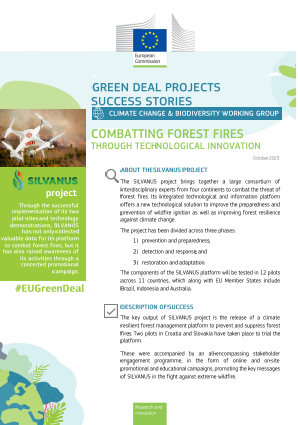About the project
The SILVANUS project brings together a large consortium of interdisciplinary experts from four continents to combat the threat of forest fires. Its integrated technological and information platform offers a new technological solution to improve the preparedness and prevention of wildfire ignition as well as improving forest resilience against climate change.
The project has been divided across three phases:
- prevention and preparedness;
- detection and response; and
- restoration and adaptation.
The components of the SILVANUS platform will be tested in 12 pilots across 11 countries, which along with EU Member States include Brazil, Indonesia and Australia.
Description of success
The key output of SILVANUS project is the release of a climate resilient forest management platform to prevent and suppress forest fires.
Two pilots in Croatia and Slovakia have taken place to trial the platform. These were accompanied by an all-encompassing stakeholder engagement programme, in the form of online and on-site promotional and educational campaigns, promoting the key messages of SILVANUS in the fight against extreme wildfire.
These included:
A demonstration of technologies including ground-robots, ‘Mesh in the Sky’ communication channels, unmanned aerial vehicles and modern satellite communication systems in Croatia.
Early detection demonstration in Slovakia followed by the efficient deployment of firefighters, fire trucks, drones, robots, and helicopters.
Highlights
Important data was collected for the development of the SILVANUS platform as a result of successful implementation of the pilots and technology demonstrations. The purpose was to verify firefighting operations, applying various tactical approaches to supress the fire, ensure connection systems are functioning and review the road network and its interconnectivity.
The key messages of SILVANUS were disseminated through 10 promotional and educational posters which described the project’s main activities. Thousands of pedestrians passing through the main street were able to see the key messages of SILVANUS in the fight against extreme wildfire, with a special emphasis on citizen engagement.
The SILVANUS citizen engagement app, where stakeholders can interact and report on fire risks and events, was promoted.
Outputs
Through the successful implementation of the pilots and technology demonstrations, important data was collected for the development of the SILVANUS platform. The purpose was to verify firefighting operations, applying various tactical approaches to supress the fire, ensure connection systems are functioning and review the road network and its interconnectivity.
This coincided with the launch of a promotional and educational campaign that was, along with the pilots, covered on French, Croatian and Slovak regional and national televisions.
Impact
With national television coverage in three countries, and with the opening of the SILVANUS exhibition supported by the highest levels of local and firefighting public administration, SILVANUS has reached a high number of stakeholders.
The results of the pilots have provided invaluable, on-site data for the development of the SILVANUS platform.
Lessons
The pilots have highlighted the possible setbacks in implementing the SILVANUS platform – from weather conditions and technical communication disadvantages, to logistics challenges, the mitigation of which will serve as an important aspect of the platform.
Other information
In the next phase, prevention and response, a large-scale volume data will be collected from diverse sources. These will then be processed to develop insights into the predictive models of the spread of fires, which take factors such as air temperature, wind direction and velocity into consideration.
In the final phase, following the complete mitigation of wildfires, the project will undertake steps towards rehabilitation and restoration activities, with recommendations on policies, legal framework, and insurance schemes.

Deployment of a M17 helicopter with a “bambi bucket” – SILVANUS pilot in Pol’ana region, Slovakia

Deployment of ground robots – SILVANUS pilot in Pol’ana region, Slovakia

Fire detection IoT device installed – SILVANUS pilot in Šapjane Training Centre, Croatia

Deployment of firefighting airplanes with water bombs – SILVANUS pilot in Šapjane Training Centre, Croatia

The SILVANUS exhibition at the main central street of Rijeka, Croatia

The SILVANUS exhibition opened by Mayor of Rijeka Marko Filipović

SILVANUS promotional poster

